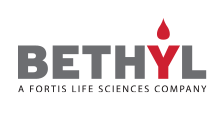NEW!
F(ab')2 Goat anti-Rabbit IgG Heavy and Light Chain Cross-Adsorbed Antibody FITC Conjugated

Bethyl Laboratories
Catalog #
Target:
Rabbit IgG Heavy and Light Chain
Reactivity:
Rabbit
Applications:
ELISA
,Flow Cyt
,ICC
,IF
,IHC
,WB
Host:
Goat
Clonality:
Polyclonal
Format:
F(ab')2
Isotype:
IgG
Conjugate:
Biotin
,DyLight® 488
,DyLight® 550
,DyLight® 594
,DyLight® 650
,FITC
,HRP
,Unconjugated
Purity:
Antigen Affinity Purified
Unconjugated (0.5 mg)
Biotin (0.5 mg)
DyLight® 488 (0.5 mg)
DyLight® 550 (0.5 mg)
DyLight® 594 (0.5 mg)
DyLight® 650 (0.5 mg)
FITC (0.5 mg)
HRP (0.5 mg)
Product Details
Specifications
Verified Reactivity
Rabbit
Antigen Species
Rabbit
Minimum Reactivity Species
Bovine, Chicken, Horse, Human, Mouse, Rat, Sheep
Concentration
0.5 mg/ml
Fluorophore/Protein
Storage
2 - 8 °C
Shelf Life
1 year from date of receipt
Physical State
Liquid
Buffer
Phosphate Buffered Saline (PBS) containing 0.2% BSA and 0.09% Sodium Azide
Request Formulation Change
Phosphate Buffered Saline (PBS) containing 0.09% Sodium Azide
Request Formulation Change
Phosphate Buffered Saline (PBS) containing 0.2% BSA and 0.05% Pro-Clean 400
Request Formulation Change
Production Procedures
Antiserum was cross adsorbed using bovine, chicken, horse, human, mouse, rat and sheep immunosorbents to remove cross reactive antibodies. The antibody to rabbit IgG was isolated by affinity chromatography using antigen coupled to agarose beads. F(ab')2 fragments were generated using a pepsin digestion. Fc fragments and whole IgG molecules have been removed. Fragments were conjugated to fluorescein isothiocyanate (FITC).
Immunoglobulin concentration was determined using Beer’s Law where 1mg/mL IgG has an A280 of 1.4.
By immunoelectrophoresis and ELISA this antibody reacts specifically with rabbit IgG and with light chains common to other rabbit immunoglobulins. No antibody was detected against non-immunoglobulin serum proteins. Less than 1% cross reactivity to bovine, chicken, horse, human, mouse, rat and sheep IgG was detected. This antibody may cross react with IgG from other species.
Antiserum was cross adsorbed using bovine, chicken, horse, human, mouse, rat and sheep immunosorbents to remove cross reactive antibodies. The antibody to rabbit IgG was isolated by affinity chromatography using antigen coupled to agarose beads. F(ab')2 fragments were generated using a pepsin digestion. Fc fragments and whole IgG molecules have been removed. Fragments were conjugated to DyLight® 488.
Immunoglobulin concentration was determined using Beer’s Law where 1mg/mL IgG has an A280 of 1.4.
By immunoelectrophoresis and ELISA this antibody reacts specifically with rabbit IgG and with light chains common to other rabbit immunoglobulins. No antibody was detected against non-immunoglobulin serum proteins. Less than 1% cross reactivity to bovine, chicken, horse, human, mouse, rat and sheep IgG was detected. This antibody may cross react with IgG from other species.
Antiserum was cross adsorbed using bovine, chicken, horse, human, mouse, rat and sheep immunosorbents to remove cross reactive antibodies. The antibody to rabbit IgG was isolated by affinity chromatography using antigen coupled to agarose beads. F(ab')2 fragments were generated using a pepsin digestion. Fc fragments and whole IgG molecules have been removed. Fragments were conjugated to DyLight® 550.
Immunoglobulin concentration was determined using Beer’s Law where 1mg/mL IgG has an A280 of 1.4.
By immunoelectrophoresis and ELISA this antibody reacts specifically with rabbit IgG and with light chains common to other rabbit immunoglobulins. No antibody was detected against non-immunoglobulin serum proteins. Less than 1% cross reactivity to bovine, chicken, horse, human, mouse, rat and sheep IgG was detected. This antibody may cross react with IgG from other species.
Antiserum was cross adsorbed using bovine, chicken, horse, human, mouse, rat and sheep immunosorbents to remove cross reactive antibodies. The antibody to rabbit IgG was isolated by affinity chromatography using antigen coupled to agarose beads. F(ab')2 fragments were generated using a pepsin digestion. Fc fragments and whole IgG molecules have been removed. Fragments were conjugated to DyLight® 594.
Immunoglobulin concentration was determined using Beer’s Law where 1mg/mL IgG has an A280 of 1.4.
By immunoelectrophoresis and ELISA this antibody reacts specifically with rabbit IgG and with light chains common to other rabbit immunoglobulins. No antibody was detected against non-immunoglobulin serum proteins. Less than 1% cross reactivity to bovine, chicken, horse, human, mouse, rat and sheep IgG was detected. This antibody may cross react with IgG from other species.
Antiserum was cross adsorbed using bovine, chicken, horse, human, mouse, rat and sheep immunosorbents to remove cross reactive antibodies. The antibody to rabbit IgG was isolated by affinity chromatography using antigen coupled to agarose beads. F(ab')2 fragments were generated using a pepsin digestion. Fc fragments and whole IgG molecules have been removed. Fragments were conjugated to DyLight® 650.
Immunoglobulin concentration was determined using Beer’s Law where 1mg/mL IgG has an A280 of 1.4.
By immunoelectrophoresis and ELISA this antibody reacts specifically with rabbit IgG and with light chains common to other rabbit immunoglobulins. No antibody was detected against non-immunoglobulin serum proteins. Less than 1% cross reactivity to bovine, chicken, horse, human, mouse, rat and sheep IgG was detected. This antibody may cross react with IgG from other species.
Additional Product Information
Anti-heavy- and light-chain antibodies are designed to react with the whole intact Ig molecule. Found in all body fluids and a primary means of protection against infection, an anti-H+L IgG antibody allows for some potential cross-reactivity to other Ig molecules and IgG molecules from other closely-related species.
Applications

